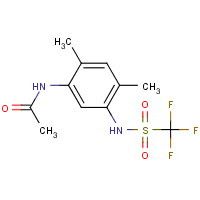Mefluidide
Agent Name
Mefluidide
CAS Number
53780-34-0
Formula
C11-H13-F3-N2-O3-S
Major Category
Pesticides

Synonyms
5'-(1,1,1-Trifluoromethanesulfonamido)acet-2',4'-xylidide; 5'-(1,1,1-Trifluoromethanesulphonamido)acet-2',4'-xylidide; 5-Acetamido-2,4-dimethyltrifluoromethanesulfonanilide; Acetamide, N-(2,4-dimethyl-5-(((trifluoromethyl)sulfonyl)amino)phenyl)-; Embark; Embark 2S; Embark plant growth regulator; MBR 12325; Mefluidide; N-(2,4-Dimethyl-5-(((trifluoromethyl)sulfonyl)amino)phenyl)acetamide; Trim-Cut; VEL 3973; Vistar; Vistar herbicide; 2',4'-Dimethyl-5'-(trifluoromethanesulphonamido)acetanilide; Acetanilide, 2',4'-dimethyl-5'-((trifluoromethyl)sulfonamido)-; [ChemIDplus]
Category
Plant Growth Regulators
Description
Solid; [Merck Index] Formulations include granular, ready-to-use liquid, and soluble liquid concentrate; [Reference #1] White, odorless, crystalline solid; [Chem Service MSDS]
Sources/Uses
Used as a plant growth regulator and herbicide; [Merck Index] Used as an anilide post-emergence plant growth regulator to suppress seed heads and fruiting and to slow plant growth to reduce maintenance; Registered for non-crop land (i.e. industrial, roadside, and public areas) and residential turf; Multiple products also contain additional plant growth regulators or herbicides (i.e. Paclobutrazol and Imazapyr); [Reference #1] Used to accelerate sugar cane ripening; [HSDB]
Comments
Mefluidide diethanolamine salt (Mefluidide-diolamine CAS# 53780-36-2) and mefluidide potassium salt (Mefluidide-potassium CAS# 83601-83-6) are considered toxicologically equivalent; Causes kidney injury and weight loss in chronic studies of dogs; Rats and rabbits exhibit tremors, hunched posture, salivation, and weight loss; Increased fetal losses in rats at doses maternally toxic; [Reference #1] A dose of 60 ppm was necessary for detection in milk of dairy cows fed for one month (no adverse effects to milk yield or quality); [REPROTOX] Hepatotoxicity observed in 18-month feeding study of rats; Decreased weaning weights noted in 3-generation study of rats (days 14-21 of lactation); No evidence of teratogenicity; [HSDB] An eye irritant; [Chem Service MSDS]
Restricted
No registered food/feed uses and no food tolerances in the US; [Reference #1]
Reference Link #1
Biomedical References
Exposure Assessment
Lethal Concentration
LC50 (rat) > 5,400 mg/m3
Adverse Effects
Neurotoxin
Other CNS neurotoxin
Hepatotoxin
Hepatoxic (a) from occupational exposure (secondary effect) or (b) in animal studies or in humans after ingestion
Diseases, Processes, and Activities Linked to This Agent
Processes
Industrial Processes with risk of exposure: